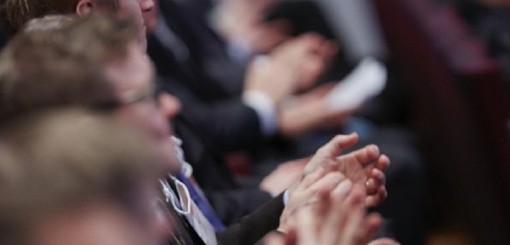As a hybrid sales strategy is predicted to be the dominant way of selling by 2024 (McKinsey), sales professionals need to continue honing their virtual sales meeting skills on top of in-person communication. In addition, the global video conferencing market is expected to reach $14.58 billion by 2029 (Fortune Business Insights), suggesting that mastering the art of the virtual sales pitch and effective online meetings will be crucial for years to come.
HOW TO MASTER YOUR VIRTUAL SALES PITCH AND WOW C-LEVEL CUSTOMERS
The ability to deliver a compelling virtual sales pitch is more crucial than ever. C-level executives, with their busy schedules and high expectations, require pitches that are concise, engaging, and tailored to their unique needs. Mastering the art of the virtual sales pitch not only sets you apart from the competition but also positions you as a forward-thinking and adaptable sales professional.
Here are five tips on how to impress C-level customers at your next digital sales meeting:
1. DO SOME ETHICAL STALKING
Researching prospects is as important as nailing your virtual sales pitch. There are several steps to take when a lead enters your sales cycle. Even if it’s a marketing qualified lead (MQL), you should dig deeper by looking into their social media profiles and websites. For example, find out what they are posting on LinkedIn and check if there are any recent news articles about current or upcoming projects at the company.
If possible, send the lead an email and schedule an initial discovery call to discuss desired outcomes, budgets, timelines, and the right decision-makers to get in touch with. Doing this pre-work will help you carve out a more precise buyer persona that will be valuable when preparing for your sales meeting. However, doing this pre-work is time-consuming and impossible to do for every lead.
It’s beneficial to invest in a service that does the pre-work for you, like ME Matchmaking, leaving you more time to prepare your sales deck and practice for the meeting.
2. MAKE THE CUSTOMER FEEL SPECIAL
Personalized customer experiences are no longer nice to have in B2B sales, they have now become a necessity. In fact, 80% of customers are more likely to make a purchase from companies that offer a personalized experience (Epsilon). At the end of the day, decision-makers are humans, and sales professionals need to make their sales presentations engaging and connect to their customer’s emotions and needs.
Virtual sales meetings give you an opportunity to create a customized presentation for each customer and share your screen to showcase any relevant promo videos and web pages. Ensure that each point presented relates back to the customer’s challenges. It’s vital to center your sales presentation around the customer instead of presenting your product’s offerings or benefits blindly.
Why ME Matchmaking partners prefer virtual meetings:
“Virtual meetings are more effective as you can prepare better, you’re in your own environment, and you have more time. You can be very direct and you can also present your slides.”
– Chris Herben, Field Marketing Manager, Commvault
3. AVOID MEETINGS ON MONDAYS AND FRIDAYS
Scheduling virtual sales meetings is tricky. Research shows that virtual meetings are badly received on Mondays and Fridays (Human Resources Online). Conversely, another study found that the best time to schedule a sales call or meeting is on a Wednesday between 4 pm and 5 pm (Salesmate).
Ultimately, the right time for a sales meeting is a time that works best for you and the decision-maker. Give your customer a few meeting time options to make things easier. Ensure that the decision-maker accepts the meeting invitation and that you send them a reminder email a day before the meeting just in case. You can also leave these administrative tasks to services like ME Matchmaking which will pre-schedule virtual sales meetings on your behalf.
Additionally, always prepare a meeting agenda so that no time is wasted during the meeting and that the customer knows what to expect. The end goal is to make every sales meeting as efficient as possible. In fact, 85% of sales prospects are more eager to join a 30-minute virtual meeting rather than an in-person meeting (LinkedIn).
Why ME Matchmaking partners prefer virtual meetings:
“Virtual meetings are terrific because you can cut to the chase much quicker. It‘s more of a conversation with virtual meetings compared to meeting people at exhibitions or conferences.” – Ronald Kerkhof, Sales Director, Smart Communications
4. DITCH THE SALES PITCH
Instead of a traditional sales pitch, why not go a step further and provide a product demo during your presentation? This makes for a more interactive and engaging sales presentation that includes the decision-maker. A product demo also allows you to practice active listening and have a two-way conversation with the customer.
During a product demo, C-level customers can ask specific questions that are related to their pain points, giving you the opportunity to provide real-time solutions to those challenges. You can also take it up a notch by calculating the ROI of your product or service in real-time, which gives you a chance to understand the customer’s budget better and even customize a package that suits their needs best.
5. PRACTICE AND HAVE A PLAN B
One huge benefit of virtual meetings is that they can be recorded. This gives you an opportunity to watch old meetings and see where you can tweak or improve. It also helps to practice your sales presentation with your colleague on the video conferencing software you intend to use. That way you can identify potential technical issues early on and get familiar with the software’s tools and functions. This is also the time to come up with a backup plan if the actual sales meeting goes awry. For example, appoint your colleague to control the slides or handle any technical issues during the meeting while you continue speaking to the decision-maker.
Why ME Matchmaking partners prefer virtual meetings:
“Most of our sales cycles take place remotely. It fits very well in the current atmosphere of business, so there are not many on-site meetings. Customers have realized they can have a virtual meeting in an hour and then jump to the next meeting.”
– Jouni Pohjola, Sales Director, Movial
After the sales meeting is done, make sure to send the decision-maker a thank-you email with a short recap of the meeting. You can also attach handouts and book follow-up meetings if needed. Don’t forget to connect with the decision-maker on LinkedIn too. All the best during your next sales meeting!










